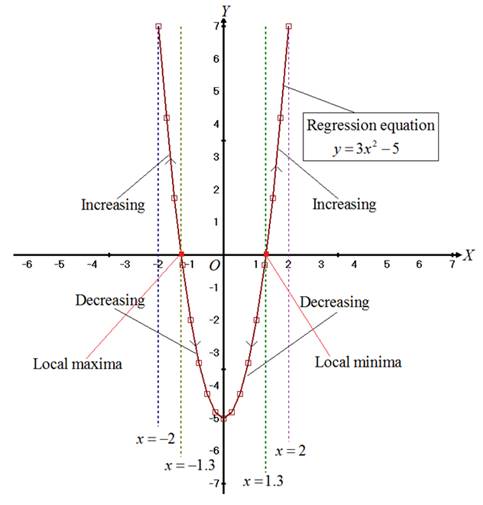
Concept explainers
(a)
To find: The find the region where the
(a)
Answer to Problem 57E
The region where the
Explanation of Solution
Given:
The given table is shown in Table 1
Table 1
| | | | |
| -2 | 7 | 0.25 | 4.81 |
| -1.75 | 4.19 | 0.5 | -4.25 |
| -1.5 | 1.75 | 0.75 | -3.31 |
| -1.25 | -0.31 | 1 | -2 |
| -1 | -2 | 1.25 | -0.31 |
| -0.75 | -3.31 | -1.5 | 1.75 |
| -0.5 | -4.25 | 1.75 | 4.19 |
| -0.25 | -4.81 | 2 | 7 |
| 0 | -5 |
Calculation:
The graph for the values given in the table is shown in Figure 1

Figure 1
Consider that the
Then, if the function has the maximum value or the local minimum value at the interior point
Consider that
Consider that
Consider that
Consider that for the given table
From this it is clear that the function increases on the interval
Consider that for the given table
From this it is clear that the function decrease on the interval
Thus, the local maxima for the given function is at
(b)
To find: The quadratic regression of the equation for the data in the table and superimpose the graph on the
(b)
Answer to Problem 57E
The required regression equation is
Explanation of Solution
Calculation:
From the table 1 when the values are entered in the calculator the regression equation is obtained as,
(c)
To find: The formula for the
(c)
Answer to Problem 57E
The function is
Explanation of Solution
Calculation:
Consider the regression equation is,
Then,
Then the function is
Chapter 5 Solutions
Calculus 2012 Student Edition (by Finney/Demana/Waits/Kennedy)
Additional Math Textbook Solutions
University Calculus: Early Transcendentals (4th Edition)
Introductory Statistics
College Algebra with Modeling & Visualization (5th Edition)
Algebra and Trigonometry (6th Edition)
Thinking Mathematically (6th Edition)
Elementary Statistics: Picturing the World (7th Edition)
 Calculus: Early TranscendentalsCalculusISBN:9781285741550Author:James StewartPublisher:Cengage Learning
Calculus: Early TranscendentalsCalculusISBN:9781285741550Author:James StewartPublisher:Cengage Learning Thomas' Calculus (14th Edition)CalculusISBN:9780134438986Author:Joel R. Hass, Christopher E. Heil, Maurice D. WeirPublisher:PEARSON
Thomas' Calculus (14th Edition)CalculusISBN:9780134438986Author:Joel R. Hass, Christopher E. Heil, Maurice D. WeirPublisher:PEARSON Calculus: Early Transcendentals (3rd Edition)CalculusISBN:9780134763644Author:William L. Briggs, Lyle Cochran, Bernard Gillett, Eric SchulzPublisher:PEARSON
Calculus: Early Transcendentals (3rd Edition)CalculusISBN:9780134763644Author:William L. Briggs, Lyle Cochran, Bernard Gillett, Eric SchulzPublisher:PEARSON Calculus: Early TranscendentalsCalculusISBN:9781319050740Author:Jon Rogawski, Colin Adams, Robert FranzosaPublisher:W. H. Freeman
Calculus: Early TranscendentalsCalculusISBN:9781319050740Author:Jon Rogawski, Colin Adams, Robert FranzosaPublisher:W. H. Freeman
 Calculus: Early Transcendental FunctionsCalculusISBN:9781337552516Author:Ron Larson, Bruce H. EdwardsPublisher:Cengage Learning
Calculus: Early Transcendental FunctionsCalculusISBN:9781337552516Author:Ron Larson, Bruce H. EdwardsPublisher:Cengage Learning





